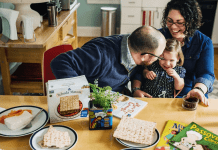My husband and I have walked into my late mother-in-law’s house for the last time.
We are in the process of settling her estate, including the sale of her house and disposition of everything in it.
From a hutch filled with china and crystal goblets to overflowing jewelry boxes and coin collections. And everything in between.
A lot in between.
Her clothes. The Notre Dame sweaters my late father-in-law was so fond of wearing. Her furniture. Furniture inherited from her mother-in-law, still in the same place in the garage where it was originally placed 30 some-odd years ago. My husband’s Cub Scout uniform. Christmas decorations. Lots and lots of Christmas decorations.
Every room, every closet, every shelf, every drawer. Full of stuff. A lifetime of stuff. Two lifetimes, if you count my father-in-law, who passed away 11 years ago.
What to Do With a Lifetime of Stuff
My mother-in-law was a neat and tidy housekeeper. But like many of us (myself included), she lived in a good-sized house with plenty of room to accommodate stuff. Things inherited from her parents and her in-laws. The broken vacuum cleaner waiting for repair in the back of the closet. Hundreds of books read once. You get the picture.
And the cost of disposing of all of that stuff? Having the estate sale company we hired go through every room, every closet, every drawer, separating the trash from the treasures, may cost more than will be generated at the eventual estate sale.
Her house has been transformed into a store, the estate sale company having cleverly arranged and displayed my mother-in-law’s possessions on tables in every room.
All of her possessions with any value, save the very few we kept, each with a tiny white price tag.
Losing your last surviving parent is hard enough. But being the arbiter of which of your parents’ and grandparents’ treasures get saved and which end up sold, donated, or in a landfill? gut-wrenching.
The lesson we have learned from this experience?
Most of the stuff in your house is worthless. And eventually, someone, either you or your kids, will be tasked with the overwhelming job of getting rid of it.
Most of Your Stuff Is Worthless
Most of the stuff in your house is worthless.
Yes, even the stuff you worry the most about, the stuff you think is so good you don’t use it for fear of breaking it, has little to no resale value.
From china, china cabinets, crystal goblets, silver tea sets, pianos, and collectible figurines like Hummels, to grandfather clocks and real pieces of craftsmanship furniture.
Why? Baby boomers have glutted the market with their castoffs, and millennials, the next generation of buyers, don’t want it.
Millennials hate both formal in-home entertaining and use of second-hand goods. With looming student loans, they tend to rent and move often. Who wants to be constantly moving a piano and a grandfather clock from apartment to apartment?
And furniture? There’s no market for so-called “brown furniture,” meaning any furniture (regardless of quality) other than the “mid-century casual” furniture (think clean, lightweight) favored by millennials. Brown furniture is basically firewood.
If it’s not in great condition, it’s also not fit for donation because it can’t be resold.
All of my mother-in-law’s furniture (including the pieces inherited from her mother-in-law and kept for decades)? Straight to the landfill.
Well, Almost Everything…
What do guns, LPs (records), and precious metals/gems have in common?
They are 3 things you might have in your house with a robust resale value.
Silverware also has value, but only if it is real silver and can be melted down.
3 Things You Should Be Doing NOW to Reduce the Amount of Stuff You Have
1. Be viciously thoughtful about holding onto sentimental items.
Here was our goal with sorting through my mother-in-law’s things. Keep just enough to remind us of her, but not so much stuff that our daughters are going to be dealing with it 40 some-odd years from now.
Here’s what we kept:
- A painting to be displayed in our dining room
- My mother-in-law’s treasured Swarovski crystal animal collection (all of which were given to her by her children and grandchildren over the years)
- Jewelry to be divided among the granddaughters
- Each of our daughters got to select 1 item
And that was it.
Well, almost. We did set aside photos to be digitized (with the originals then destroyed).
Was it hard leaving everything else? You bet it was. But we don’t want to be dealing with a lot of stuff years from now (or worse, leaving it to our daughters to deal with).
I try to be viciously thoughtful with my own sentimental items. For example, I don’t save any school papers or art projects from my kids (though I do take photos of my favorites).
2. Buy fewer books.
While used book resellers like Half Price Books do an important service in keeping books in circulation, a surprising number of books end up in landfills because many paper recycling facilities can’t process the the glue that binds book spines.
My resolution last year was to cut down on my book consumption by only reading books that I borrow from the library or purchase on my Kindle e-reader. If you haven’t used a library in years, now is the time to go back. My local library has an app where you can “order” books online, and pick them up the next day on a special “hold” shelf strategically placed next to the check-out kiosk.
How successful was I on my resolution? I read 1 to 2 books a week in 2019, only 1 of which was a hard copy purchased from Amazon.
3. Buy fewer, but better quality, clothes
The world is overflowing with used clothing.
We buy substantially more clothing over our lifetimes than our grandparents did.
Clothing made today is meant to last no more than a few years. In fact, a lot of clothing isn’t even made to withstand more than a few washes.
Think you are “paying it forward” but dropping off a load of unwanted clothes at Goodwill? Think again. Most clothing donations never make it to the racks at Goodwill and only about a third of what does eventually sells.
To really pay it forward, cut down on the amount of clothing you have by buying better quality clothes that last longer.
Keeping What Really Matters
My 5-year-old chose to keep a Christmas music box from her Grandma’s house. It plays “White Christmas” and has tiny ice skaters going around a rink inside. Each Christmas, my mother-in-law would bring out this music box and let each of her granddaughter’s play with it. It’s value in preserving a precious memory of Grandma? Priceless.














The key to Dave’s comment is “at a fraction of new prices”. The author is correct: our kids don’t want our collections. They are not interested in silver flatware, “good” china, or crystal that won’t go in the microwave or the dishwasher. They don’t want Hummels or any other collectibles we have valued as they will need to be dusted. It is sad that they don’t value at all heirloom pieces that are part of the history of our family. But my advice: sell it now (at a fraction of its original price) and use the cash to enjoy your retirement years. The kids won’t appreciate your saving it for them!
This Author just sounds so cold hearted. She seems to think that our lives didn’t count, just because some don’t care for our “stuff”, but we sure do enjoy it, and my children can do with it what they will when I am gone. I have not repeated anything so go ahead and post my comment please.
We have a non-profit organization near me that accepts basic household goods like furniture, china, kitchenware, linens, etc. They accept donations, organize them in their warehouse, and then invite people in need via a referral program that they set up with various shelters and organizations to shop for what they need at no cost. Maybe there’s one near you. (Here’s the link if you need inspiration and/or more details http://www.HouseholdGoods.org)
As others have stated, the more we keep out of landfills the better. Another great site is http://www.earth911.com where you can find out how and where to recycle most items.
I agree in some respect that our children don’t want a lot of things we cherish but my daughter is constantly asking for things that were my mom’s! Some things my parents left behind were appraised quite high by a well known auction house! Sooo it’s not all junk! I downsized after my husband passed and am living a downsized life now.
This article does make me sad. I’m 73 and have 3 daughters who probably won’t want my beautiful mahogany dining room table and china cabinet and sideboard that were my mother’s and that I’ve always loved!! And the mahogany piano that was mine when I was little. It makes me very sad thinking about these articles I’ve read where the next generation doesn’t want these things that were handed down to us. I do appreciate your perspective though about the clothes and the books. Sad to realize that all of this “stuff” ends up in landfills.
Not an alternate universe, just the majority. This all rings true. Families do not know what to do with China sets, silver service and all kinds of things no one wants anymore. So sad.
These younger people will settle down one day and, hopefully, will want quality furnishings. The cheap stuff they use in the beginning will not last like the old stuff!! Save it for a while anyway and give your children an opportunity to grow into it before you dispose of those items which will eventually be precious memories for your children and beautiful furnishings for their homes.
where’s the joy in thinking of the years they enjoyed!
Dave, I attend and buy at Estate sales — and so do a lot of other 65 + people. I do not recall seeing any 20 somethings buying anything at estate sales. In fact they aren’t even there. Most of the heavy furniture is still there on Sunday afternoon when the prices are slashed.
Why in the world would you destroy original pictures?